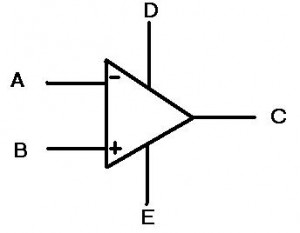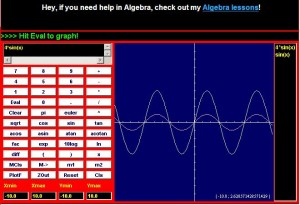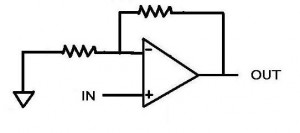As promised, this post is a follow up post to explain the real-world behavior of an op amp. Here we will continue to anthropomorphize op amps in order to better understand their behavior and what they “want” to do. Also, we will look at some more complicated (but common) op amp configurations so that they are easily recognizable. Let’s begin.
First, let’s look at the symbol for the op amp:
Whoa-ho! What the heck are those? Last time, there was only 3 lines coming out of the triangle and now there’s five! They’re multiplying!
Really the “D” and “E” inputs are the power inputs to the op amp. This means we are no longer simply dealing with the “ideal” case and are now going to look at the behavior with some realistic expectations. I know that when I was first learning about op amps, I was perplexed by this idea. I thought, “Well what is the point of putting power into an op amp? What do I get for it?” The idea is that as long as the signal at the input (or more accurately the difference between “A” and “B” is smaller than the power at the “D” and “E” terminals, then the op amp can amplify the signal. This gets very useful once you start encountering signals that change over time, or AC signals (as opposed to DC signals). Let’s look at this idea below:
Special thanks to CoolMath.com for the graphing program!
On the top left, we see a SINE wave, which is one of the simplest time varying signals there is. Amplifying this signal would not shift the signal, but instead would make the entire range of the signal larger. If we used a 4x amplification, then we would get the top right picture with the larger signal. Notice in the bottom picture the overlay of these two signals. They do not SHIFT up, but instead look like they are stretched. The easiest way to think of all this is at the extremes. If in the first picture the highest point was 1 and we had 4x amplification, then the output would be 4. However, the middle point is 0 and that multiplied by 4 is still zero. Hence the reason the overlay shows the extreme highs and lows being “stretched” the most. Also, it is important to note that these are analog signals, so EVERY point in between the extremes is being amplified.
The power coming into the op amp also restricts how much the op amp can amplify a signal. Not only that, but sometimes you don’t even get to go to the limits! Say you have +15 volts attached to “D” and -15 volts attached to “E” (most op amps have lower voltages these days but +/- 15 volts still happens sometimes). Now let’s say you have a 1V signal coming into a non-inverting amplifier (shown below). The gain on this amplifier is set to 15 by making the top resistor 14 times less than the resistor connected to the ground (non-inverting amplifiers have a gain of 1+R(top)/R(gnd)). So our 1 volt signal is placed at the non-inverting input (the plus) and the op amp says “15 volts, coming right up!”. Ah, but the op amp doesn’t quite have it. The op amp outputs 13.4 volts are so and then stops. “But WAIT!” you say, “why can’t this op amp output as much as I wanted? The ideal ones can output INFINITY. Can’t I just get one of those?” The short answer: no, you can’t. Op amps have internal protection circuitry that limits how high the input to the op amp can be in order to protect it from blowing up. Additionally, the op amp must consume some of that power in order to actually amplify the input signal; this will be expounded upon in further posts (the internals of an opamp).
The final point in this continuing discussion about op amps, is known as slew rate. Really it is a discussion of how fast an op amp can go and is limited by capacitance. Inside of any op amp, there is a capacitor, or rather a bunch of components that act together as one capacitor. This creates a required charge time for the internals of the circuit (for a more advanced look at this topic, check out the allaboutcircuits.com article on capacitors and calculus). The end result is that the op amp has some limit to how fast it can “decide” what the output should be. If we think back to the signals above that alter with time, we can imagine a situation where they would vary so quickly that an op amp would not be able to keep up. The end result is that a circuit such as the non-inverting amplifier shown above has some frequency above which it can no longer accurately amplify. This is known as the bandwidth of the circuit and has implications in many audio, measurement and communication industries.
This post discussed some of the real world aspects of op amps. The next post will discuss the internals of the op amp, such as the transistor setups. Imperfections in the silicon and the realities of material science will show us that more of the “ideal” op amp model is not possible in every day life; some potential topics are the input bias currents, the voltage offsets across the input terminals and how they can affect everyday circuits.
[xyz_lbx_default_code]





22 replies on “How an op amp works — Part 2”
[…] the basics of it. Check back here for more about op amps, because there is a lot more to be said. Future posts might include other op amp configurations, […]
[…] though I got the capacitors and transistors in for my Wurlitzer 200A, I decided to write about something else before I started documenting the […]
[…] it seems that I may have broken the amplifier on my Wurlitzer 200A. This after I took my sweet ol’ time getting all the replacement parts […]
[…] running through a device. If you look at the path of an electron along a trace on a microchip or op amp, it resembles a “tunnel” that electrons flow through. As process technologies get […]
[…] an op amp works — I set the op amp apart from the passives because it is an active component (duh) and because I think that it’s […]
[…] Pease. I’m only just starting the book, but enjoyed the simplified model of slew rate in an op amp and thought it would look cool on the top of the page. If you have any other thoughts or additions […]
[…] can induce a certain behavior. So as long as the models for high level components (say an op amp or a buck converter) are well thought out, they often can represent the real world equivalent quite […]
[…] the next best thing. Unfortunately for older products, this can often mean that components such as op-amps or a buck converter will no longer be produced. It’s a symptom of being in a dynamic industry […]
[…] because of the nuances the real circuit will show you. Perhaps you forgot to model a realistic op amp in your SPICE simulation and it was outputting 500 A. Perhaps you didn’t realize in your […]
[…] Chris Gammell Related Posts:In the Metal Recycling Business, It’s Loud, Dirty and Suddenly LucrativeMorozov: […]
awsum! thanx…i realy wantd to know ths frm th basic..txt buk just gv sum non sense. sum times they 4gt to provide proper basics.this helpd me a lot to understand .wud b pleased if u wud xplain the working of th op amp as an integrator and differentiator
Wow.
Please sir, wait until AFTER your seizure before attempting to operate any electronics.
In your discussion about making the top resistor 14 times less than the resistor connected to the ground, I think you ment 14 times larger.
yes is ok what you say , is 14 times larger
maybe it's just me, but your part 2 completely missed it's target.
you give a simple explanation about a sine wave, then setup a circuit
with the two ratio-based resistors, introduce D and E….and then you never
actually work the 1V problem or use the sine wave on the circuit.
you derailed the point of that discussion with the op-amps power limitations.
what a bummer…I'd still like to see the math worked for the
sine wave…
Hello,
Thanks for the article!
I have a Q though:
In all the imperfections of the op amp, is it possible to amplify a voltage as little as 1mV to between 5 and 10 volts? If yes, what type of op amp can do this (e.g can the 741) do this? What values of R1 and 2 as well as power supply can achieve this?
Thanks for your response!
Regards!
thanks. it is a great article. can you rearrange your articles, so they make a full story. for example, you said " The next post will discuss the internals of the op amp", and i have checked your several archives, but i dont know which date you posted your next article on Op-Amp and which is the next one i should read before jumping my guns to some bigger topic.
keep up the good work.
Hey Chirs,
when I was reading the following : ” So our 1 volt signal is placed at the non-inverting input (the plus) and the op amp says “15 volts, coming right up!”.” I dint understand why the op-amp decided to output 15 volts when we are giving in the non inverting input 1 volts.
Don’t we need a zero at the output so that this is fed back to the inverting input in order to have same values at the inputs of the op-amp?
Thank you ,
Rasna
Is that because the op-amp is being powered by 15V, so that’s the maximum power available?
very accurately explained. Thanks Chris
-Sojwal
Help me to get future post.